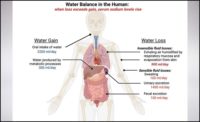The COVID-19 pandemic brought to the forefront the need to decrease indoor respiratory disease transmission. The question we are left with is, how do we manage IAQ to support human health without abandoning existing energy efficiency goals?
To date, the engineering focus on decreasing the concentration of airborne viruses has been to increase ventilation rates and improve filtration with the option of adding air-cleaning strategies, such as germicidal ultraviolet light. While these steps can decrease the number of infectious aerosols in occupants’ breathing zones, they can also result in significantly increased energy consumption. Furthermore, these interventions do nothing to support the defenses of occupants to infectious viruses. The only way to improve our defenses is to support the natural human respiratory immune system. We now know, thanks to research in immunology, epidemiology, and infectious disease, that maintaining midrange indoor air hydration, or relative humidity (RH), between 40%-60% dramatically improves our respiratory immunity.
The goals of pandemic and post-pandemic IAQ management now have a threefold job:
- Reducing the risk of exposure to airborne viruses;
- Supporting the immune system of occupants; and
- Continuing to achieve energy efficiency goals. One way to achieve this is through a holistic and passive approach to optimizing indoor temperatures and RH, known as hygrothermal performance. Using architectural materials that passively adsorb and release water vapor from microscopic pores, walls made of vapor permeable and hygroscopic materials, sometimes called “breathing walls,” can significantly enhance IAQ.
Buildings with good hygrothermal performance modulate swings in heat loss or heat gain, decreasing energy use by mechanical systems that would otherwise be on to dampen increases. Improving temperature and humidity performance of a building passively can be accomplished by exposing structures with micropores to indoor air. The unique porous structure of hygrothermal materials allows adsorption and the release of water vapor during RH fluctuations, thus adjusting the indoor humidity and managing indoor latent heat loads. For example, when humidity starts to rise, the porous material adsorbs moisture according to the pore size and surface area of the material. Conversely, when humidity decreases below the desorption set point, adsorbed water molecules are released and maintain midrange indoor humidity.
If a material can quickly adsorb moisture from the air, this material will maintain the RH at its surface at a lower, more stable level while also moderating short-term interior air humidity variations.
The water vapor capacity and the rate of adsorption-desorption are determined by the pore size and surface functional groups of the material. According to the Kelvin capillary condensation equation, water vapor has reversible adsorption-desorption performance when the material pore size ranges from 2-20 nm. Results from material studies, beyond the scope of this column, show that humidity control performance can be modulated by the addition of hydrophilic groups, such as -OH, -CHO, -COOH, and -NH2 into the material.
While using hygroscopic materials to control indoor temperatures and humidity is not a new strategy, it is often neglected in modern buildings. Untreated wood, concrete, stone, and brick are often found in vernacular architecture and, recently, in deliberately passive designs. Using building materials as water vapor storage sites would modulate wide RH fluctuations, avoiding unhealthy IAQ from low RH (less than 40%) or liquid condensation from high RH (greater than 60%). When added to controlled ventilation, filtration, and humidification, good IAQ can be achieved with a much-decreased energy cost.





